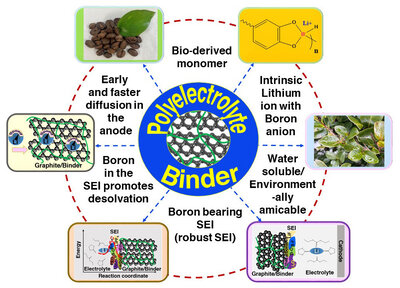Speeding up charging capability for Li-ion batteries

A group of researchers from the Japan Advanced Institute of Science and Technology (JAIST) have synthesised a lithium borate-type aqueous binder for graphite anodes; the new binder helped improve Li-ion diffusion and lower impedance compared to conventional batteries. Society is currently switching from fossil fuels to renewable resources and electric batteries, but faces challenges related to efficiency and sustainability. For instance, the mass market adoption of lithium-ion (Li-ion) batteries for use in electric vehicles is hindered by their slow charging speeds. The automobile industry aims to implement a range of features in batteries, including ‘extreme’ fast charging (wherein 80% of the battery is charged within 10 minutes), and high energy density and cycle life.
In order to enable the fast-charging ability in batteries, researchers have attempted to enhance the mass transfer of electrolytes and charge transfer in electrodes, with extensive research carried out on the former compared to the latter. Now, a study by a team of researchers, led by Professor Noriyoshi Matsumi from JAIST, has demonstrated a new approach to facilitate fast charging using a binder material that promotes Li-ion intercalation of active material. The binder material leads to improved diffusion of desolvated Li-ions across the solid electrolyte interface (SEI) and within the anode material, and yields high conductivity, low impedance and good stability. The research findings were published in the journal ACS Material Letters.
Corresponding authors Professors Matsumi and Badam of JAIST said their current strategy of using a bio-derived borate polymer as an aqueous polyelectrolyte binder to enhance charge transfer within electrodes such as graphite anodes exhibits fast-charging capability. While most research on batteries is focused on the design of active materials and improved mass transfer of electrolytes, the current study provides a different approach.
“The binder material includes highly dissociable lithium borate, which improves lithium-ion diffusion in the anode matrices. Further, this binder can form an organoboron SEI, which shows very low interfacial resistance when compared with ordinary battery cells,” Matsumi said.
Boron compounds (such as the tetracordinate boron in the binder and the boron-rich SEI) aim to aid the desolvation of Li+ by decreasing the activation energy of desolvation of Li+ from the solvent sheath at the SEI. With high diffusion and low impedance, the overpotential related to charge transfer at the interface is reduced. “This is one of the important determining factors for extreme fast charging," said Dr Anusha Pradhan of JAIST, first author of the paper.
Generally, when charging surpasses rate of intercalation, Li plating occurs on graphite electrodes; this can lead to reduced battery life and limit fast-charging capability. In this study, the improved diffusion of ions across the SEI and within the electrodes limits the concentration polarisation of Li+ ions, leading to the absence of plating on graphite.
In the study, the researchers presented a novel strategy for high-rate chargeable batteries and reduced interfacial resistance. They also used a biopolymer derived from caffeic acid. A plant-based organic compound, caffeic acid is a sustainable and environmentally safe source of material. Thus, while the market for these batteries increases, the use of bio-based resources in these batteries will also reduce carbon dioxide emissions.
“In future studies, our binder can also be combined with high-rate chargeable active materials to enable further synergistic effect in enhancing performance. Through the high-rate chargeable battery technology, people will enjoy electric vehicles and convenient mobile devices,” Matsumi said.
Novel method to extend lifecycle of Li-ion batteries
Researchers have uncovered a hidden surface degradation mechanism in the cathodes of lithium-ion...
Sensor could help prevent Li-ion battery fires
Researchers have developed new technology to detect dangerous gas leaks in lithium-ion batteries,...
Study sheds light on energy density of solid-state lithium batteries
Researchers have found that an all-solid-state lithium metal battery achieves an energy density...







